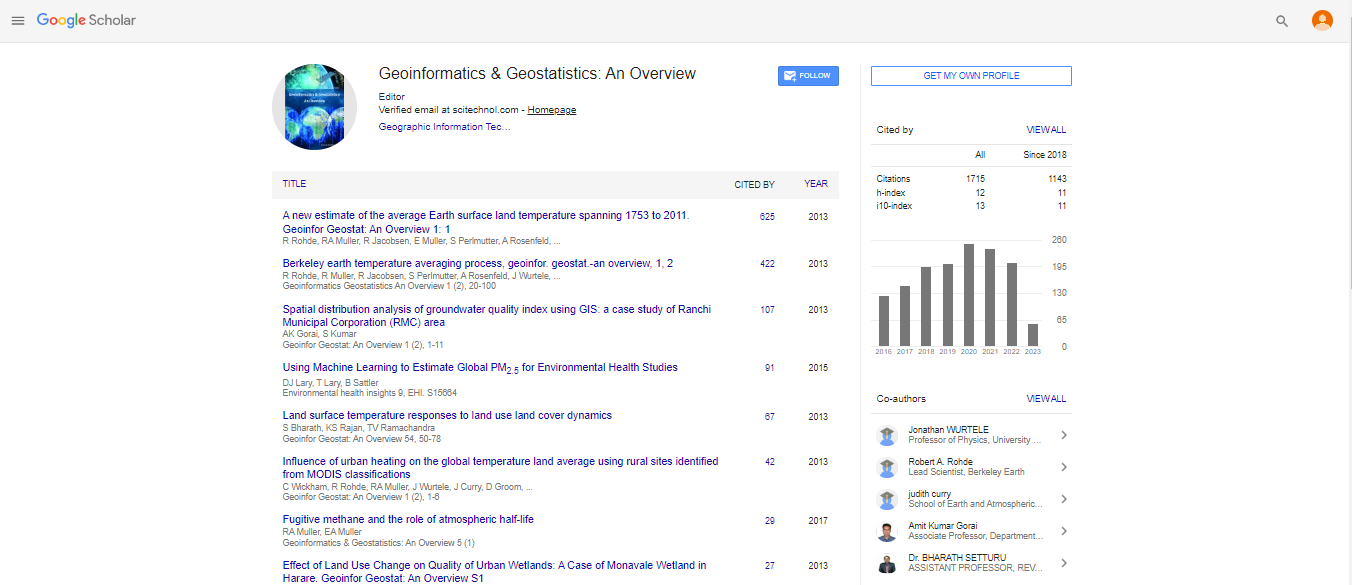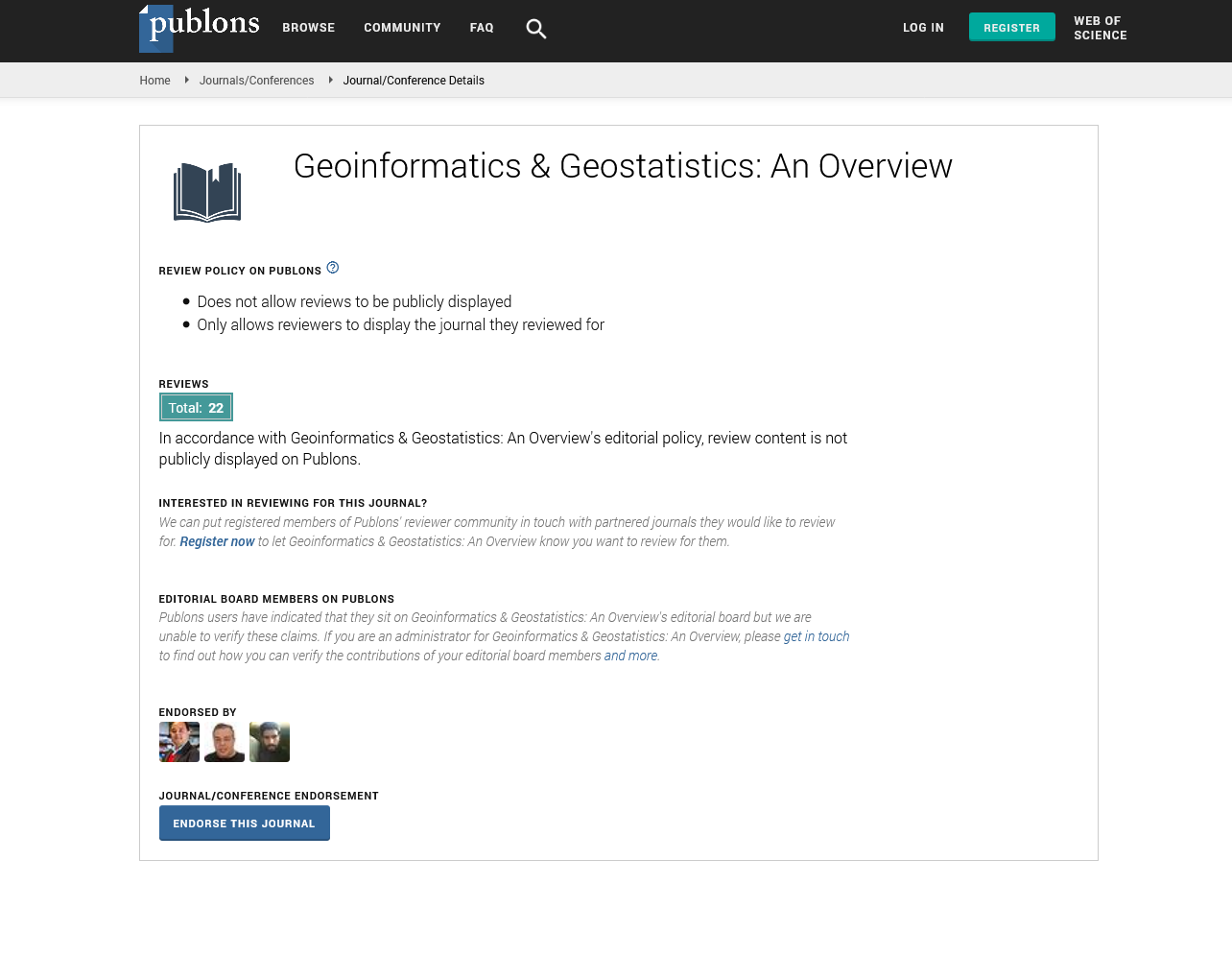Perspective, Geoinfor Geostat An Overview Vol: 13 Issue: 3
Geomorphic Perspectives on Flood Hazards: Advancing Integrated River Basin Management
Liu Boa*
Institute of Rural Development Planning-Lake Zone Centre, Mwanza, Tanzania
*Corresponding Author: Liu Boa
Institute of Geographic Sciences and Natural Resources Research, Chinese Academy of Sciences, Beijing, China
E-mail: 56584976223@qqq.com
Received date: 06 May, 2025, Manuscript No. GIGS-25-166433; Editor assigned date: 08 May, 2025, PreQC No. GIGS-25-166433 (PQ); Reviewed date: 22 May, 2025, QC No. GIGS-25-166433; Revised date: 25 May, 2025, Manuscript No. GIGS-25-166433(R); Published date: 03 June, 2025, DOI: 10.4172/2327-4581.1000439
Citation: Boa Liu , (2025) Geomorphic Perspectives on Flood Hazards: Advancing Integrated River Basin Management. Geoinfor Geostat: An Overview 13:3.
Introduction
Flood hazards are traditionally addressed through hydrological models and infrastructure-based mitigation strategies. However, such approaches often overlook the geomorphic processes that shape river systems and influence flood behavior over time. This perspective argues for the integration of geomorphic understanding into flood hazard assessments, emphasizing the dynamic interactions between sediment transport, channel morphology, and human interventions. We highlight the need to shift from static flood models to adaptive, landscape-based frameworks that consider river evolution and feedback mechanisms. Drawing on case studies from sediment-rich river basins, we propose a systems approach that aligns flood risk reduction with sustainable geomorphic functioning.
Flood hazard paradigms
Floods are among the most destructive natural disasters, yet our understanding and management strategies often fall short of addressing their true complexity. Prevailing models focus primarily on hydrological inputs rainfall, discharge, and runoff while treating river channels as static conduits. This simplification neglects a critical dimension: rivers are geomorphic systems, continuously shaped by erosion, sedimentation, and channel migration. These processes directly influence flood magnitude, frequency, and impact.
As climate variability intensifies and land-use changes accelerate, the interaction between geomorphology and hydrology becomes more pronounced. There is an urgent need to reframe flood hazard through a geomorphic lens one that embraces the river as a dynamic landscape element, not a fixed boundary condition.
Channel migration and avulsion
Rivers such as the Kosi and Brahmaputra routinely shift course across wide floodplains. Channel migration, when not accounted for, can render flood hazard maps obsolete within a decade. Avulsions sudden shifts in river course create extreme flood conditions in previously safe zones.
Sediment dynamics and channel capacity
Flood magnitude is not solely a function of discharge but also of sediment load. Aggradation reduces channel depth and capacity, causing overbank flows at lower-than-expected water levels. Sediment trapping behind dams may also starve downstream channels, inducing bed degradation and bank failure.
Human modifications and geomorphic disruption
Structural interventions such as levees, embankments, and river straightening often disconnect rivers from their natural floodplains. These measures may prevent localized flooding temporarily, but they also elevate long-term flood risks by accelerating channel instability and sediment buildup.
Most flood hazard models use static DEMs and historic flow data to estimate flood extents. While valuable for short-term forecasting, these models assume that river morphology remains unchanged over time. In sediment-laden and monsoon-driven rivers, this assumption fails. Moreover, disaster mitigation policies rarely account for the slow, cumulative impacts of geomorphic changes. Risk maps may not capture areas vulnerable to future avulsion or sediment-induced flooding. The result: reactive flood management rather than anticipatory planning.
Geomorphically-informed flood management framework
Integrating morphodynamics into flood risk mapping: Dynamic modeling tools such as cellular automata, landscape evolution models, and time-series geomorphic indicators (e.g., bank erosion rate, channel migration distance) should be included in risk assessments.
Nature-based solutions rooted in geomorphic understanding: Riparian buffer zones, floodplain reconnection, and sediment budgeting offer sustainable alternatives to hard infrastructure. These solutions not only reduce flood peaks but also restore geomorphic equilibrium.
Participatory river basin planning: Flood mitigation cannot be isolated from land-use planning, watershed development, and community engagement. A geomorphic perspective supports Integrated Water Resource Management (IWRM), aligning hazard reduction with ecological resilience.
Conclusion
Flood hazard is not merely a function of water volume it is deeply intertwined with the physical landscape through which that water flows. By acknowledging geomorphic processes as fundamental drivers of flood behavior, we can develop more adaptive, place-based strategies that balance human safety with riverine health. It is time to move beyond static flood control toward resilient coexistence with dynamic river systems. A geomorphic perspective offers the conceptual and practical tools to get there.
 Spanish
Spanish  Chinese
Chinese  Russian
Russian  German
German  French
French  Japanese
Japanese  Portuguese
Portuguese  Hindi
Hindi 
